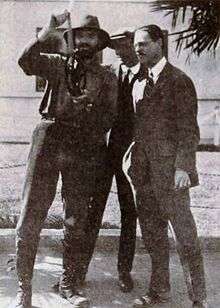B. Reeves Eason
William Reeves Eason (October 2, 1886 – June 9, 1956),[1] known as B. Reeves Eason, was an American film director, actor and screenwriter. His directorial output was limited mainly to low-budget westerns and action pictures, but it was as a second-unit director and action specialist that he was best known. He was famous for staging spectacular battle scenes in war films and action scenes in large-budget westerns, but he acquired the nickname "Breezy" for his "breezy" attitude towards safety while staging his sequences—during the famous cavalry charge at the end of Charge of the Light Brigade (1936), so many horses were killed or injured so severely that they had to be euthanized that both the public and Hollywood itself were outraged, resulting in the selection of the American Humane Society by the beleaguered studios to provide representatives on the sets of all films using animals to ensure their safety.
B. Reeves Eason | |
|---|---|
 Eason (left) showing screenwriters Lucien Hubbard and Douglas Z. Doty film from the Western Two Kinds of Love (1920) | |
| Born | William Reeves Eason October 2, 1886 New York City, New York, U.S. |
| Died | June 9, 1956 (aged 69) Sherman Oaks, California, U.S. |
| Other names | B. Reaves Eason Breezy Eason Reeves Eason "Breezy" Reeves Eason |
| Occupation | Director, actor, screenwriter, second-unit director, assistant director |
| Years active | 1914–1950 |
| Spouse(s) | Jimsy Maye |
Career
Born in New York City, Eason directed 150 films and starred in almost 100 films over his career. Eason's career transcended into sound and he directed film serials such as The Miracle Rider starring Tom Mix in 1935. He used 42 cameras to film the chariot race as a second-unit director on Ben-Hur (1925), the climactic charge in Charge of the Light Brigade (1936), and also directed the "Burning of Atlanta" in Gone with the Wind (1939).
Family and personal life
His son, B. Reeves Eason Jr., was a child actor who appeared in 12 films, including Nine-Tenths of the Law, which Eason, Sr. directed. Born in 1914, he died in 1921 after being hit by a runaway truck outside of his parents' home shortly after the filming of the Harry Carey silent western The Fox was completed, just before his seventh birthday.
Death
On June 9, 1956, Eason died of a heart attack at the age of 69. He is buried in Hollywood Forever Cemetery in Los Angeles.
Filmography
Director
References
- Eugene Michael Vazzana (2001). Silent Film Necrology. McFarland. pp. 151–. ISBN 978-0-7864-1059-0.